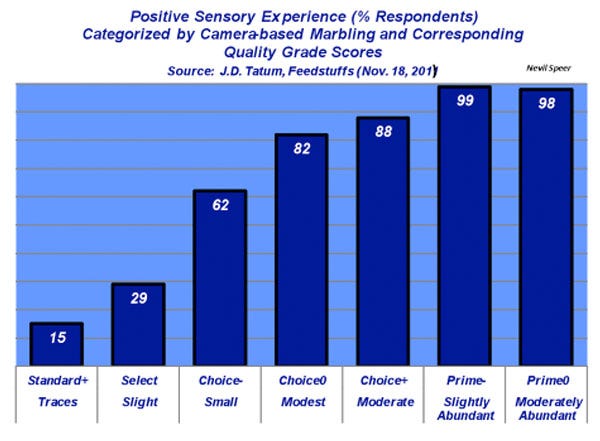Industry At A Glance: The Importance Of USDA Quality Grade
Will the use of camera technology in the quality grading of beef play a bigger role in producers' genetic and management decisions?
May 9, 2013

Last week’s “Industry At A Glance” chart focused on USDA Quality Grade trends over time. That’s inherently an important metric with respect to overall consumer satisfaction.
One of the major criticisms of the current system is the relative inconsistency among the various grades – the variability resulting from human error by USDA graders. However, new camera technology removes subjectivity, and minimizes the potential for variability across USDA Quality Grades.
To validate that perspective, the National Cattlemen’s Beef Association recently commissioned a checkoff-funded study to investigate the relationships between consumer perception and marbling scores as determined by a camera-based system. The research was led by Daryl Tatum, Colorado State University professor of animal science. The graph below details the relationship between camera-based marbling scores and relative consumer perception.

Tatum explains that, “Results of this recent study suggest that camera-based marbling scores very effectively categorize A-maturity beef carcasses according to differences in strip loin tenderness, flavor and juiciness, and provide strong support for USDA’s recent implementation of camera-assisted quality grading. The transition to camera-assisted quality grading modernizes the 85-year-old beef grading system and improves the consistency and accuracy of quality grade determination.”
The implication is that improved quality grade scores really do matter when it comes to general consumer perception of the beef industry by consumers. Moreover, the current marketing system appears to be fairly effective in segregating that value – as long as the segregation occurs in an objective manner.
How do you perceive the importance of this technology and USDA Quality Grade influencing the business in the future? Will it play a bigger role in genetic and management decisions? Will consumers become even more aware of these potential differentiations going forward? Leave your thoughts below.
You might also like:
Industry Reduces E. coli By 90%, But Little Progress With Salmonella
Jimmy Hagood's Top Three Tips For Great Backyard Barbecue
5 Ways To Celebrate May Beef Month
About the Author(s)
You May Also Like




.png?width=300&auto=webp&quality=80&disable=upscale)
